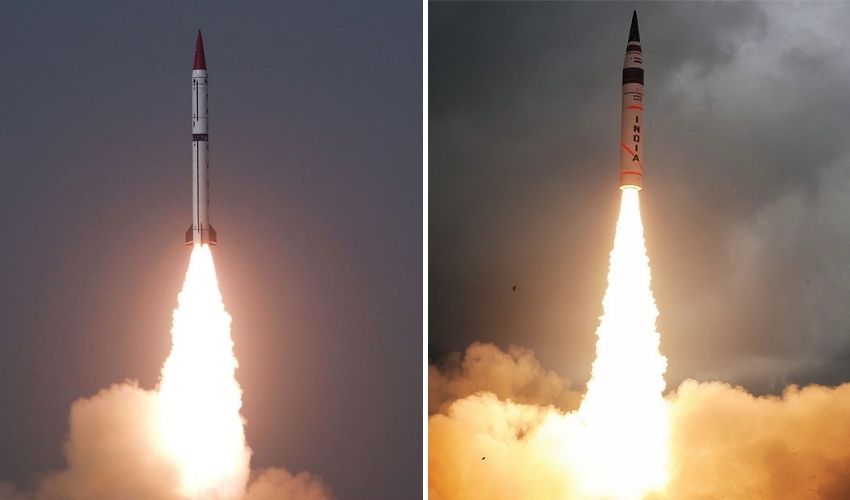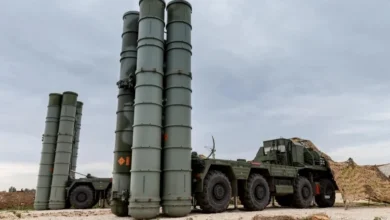How Will Pakistan’s Shaheen-3 Missile Compete Against India’s “Fire-Breathing” ICBM Agni-5?

This was the missile’s second test in the previous two years, with the first taking place on January 20, 2021. The “test flight was aimed at revalidating several design and technical characteristics of the weapon system,” according to Pakistan’s DG ISPR, although the timing of the test raises issues.
Is Shaheen-III a missile system aimed against India’s northeast?
After India successfully test-fired Agni-III, a missile capable of reaching any target inside Pakistan, the development phase of Shaheen-III began in the early 2000s.
The Shaheen-III is a land-based surface-to-surface medium-range ballistic missile with nuclear capability. The missile was initially fired on March 9, 2015, and was later showcased at a military parade in March 2016.
With a range of 2,750 kilometres, it is Pakistan’s longest-range missile. The missile is propelled by a two-stage solid propellant system. A Chinese transporter erector launcher was used to launch the road-mobile missile. Shaheen-III was meant to attack India’s northeast and island commands, according to Lieutenant General (Retd) Khalid Kidwai.
“Shaheen-III is designed to reach Indian islands so that India cannot utilise them as “strategic bases” to create “second-strike capabilities,” the general said in an interview at the Carnegie International Nuclear Policy Conference in 2015.
Given that the Shaheen-III is Pakistan’s most powerful missile, testing it against India’s most powerful nuclear-capable missile, the Agni-V, is critical. The Defense Research and Development Organization created the Agni-V, a nuclear-capable intercontinental ballistic missile (ICBM) (DRDO).
The missile has a range of 5,500-8,000 kilometres in operation.
Agni-V is a three-stage solid propellant spacecraft that is delivered by truck and launched using a canister. During the final phase, it reaches a maximum velocity of Mach 24. It is directed by an inertial navigation system with a ring laser gyroscope that can hit a target within 30 metres.
Agni-V, on the other hand, was designed primarily to strengthen India’s nuclear deterrence against China. Agni-V can reach China’s eastern seaboard, where the majority of the country’s economic activity is concentrated, with a range of more than 5,000 kilometres.
In 2018, India’s Strategic Forces Command deployed the missile.
Given that the Shaheen-III is Pakistan’s most powerful missile, testing it against India’s most powerful nuclear-capable missile, the Agni-V, is critical.
Versatility Offered By Agni-V
The Defense Research and Development Organization created the Agni-V, a nuclear-capable intercontinental ballistic missile (ICBM) (DRDO). The missile has a range of 5,500-8,000 kilometres in operation.
Agni-V is a three-stage solid propellant spacecraft that is delivered by truck and launched using a canister. During the final phase, it reaches a maximum velocity of Mach 24. It is directed by an inertial navigation system with a ring laser gyroscope that can hit a target within 30 metres.
Agni-V, on the other hand, was designed primarily to strengthen India’s nuclear deterrence against China.
Agni-III, like Shaheen-III, features a two-staged solid propellant propulsion system. In terms of mobility and launch versatility, Agni-III outperforms Shaheen-III.
Agni-III is both rail and road-mobile, whereas Shaheen-III is solely road-mobile. Shaheen-3’s guiding system is inferior to Agni- III’s. Agni-III is guided by GPS satellites and uses the same Ring Laser Gyroscope inertial navigation technology as Agni-V. Night experiments are also being conducted by the DRDO to improve the missile’s capability and establish readiness to handle the weapon at night.
Pakistan sees Shaheen-III as a credible deterrent against India’s superior missile capability because of its increased range.
“Pakistan appears to be looking at competing with India, and Pakistan’s ambitions seem to revolve around generating a credible deterrence, and a credible deterrence is certain to increase strategic stability,” said Farrukh Salim, a Pakistani political scientist.
Pakistan believes the Shaheen-III will thwart India’s second-strike capability. It is important to remember, however, that India possesses a fully operational nuclear triad, and that simply striking its land-based launching sites will not render India’s second-strike capability inoperable.
With the introduction of Shaheen-III, Pakistan has made significant progress in establishing credible deterrent. They are, however, still far behind India in terms of missile technology. Even with China’s assistance, they will take years to catch up.







Facebook Comments